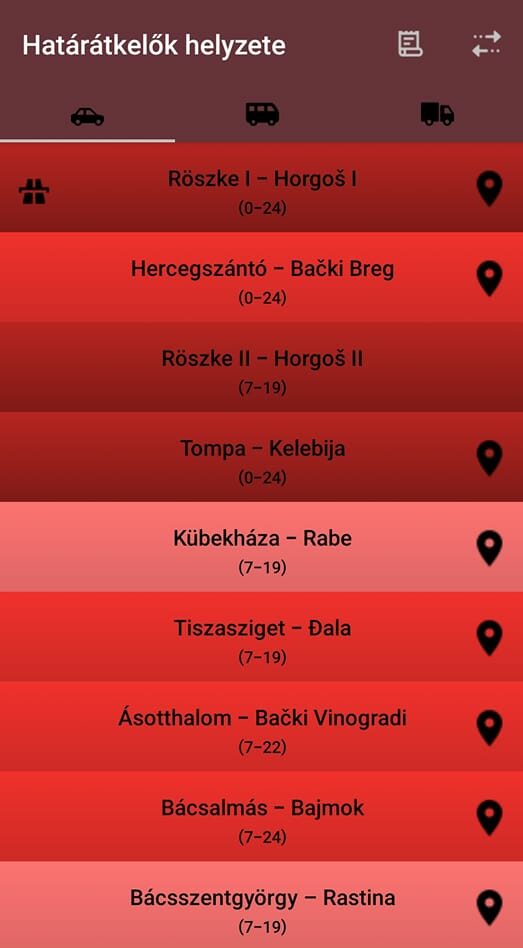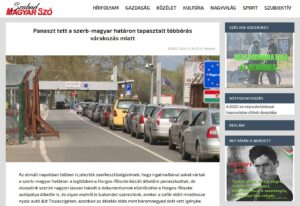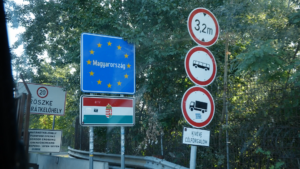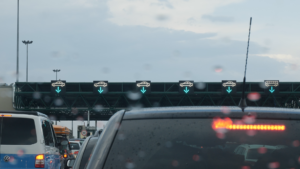
The 2020-21 pandemic substantially reduced the number of international trips, but it seems that travel trends have also changed since the end of the pandemic, as the 2022 figures show that the Horgoš-Röszke motorwayborder crossing is not only below the pre-COVID-19 figures, but even below the 2021 indicators. This means that the number of travellers crossing the border is decreasing, unlike the waiting time. IT system breakdowns and unnecessarily long checks compared to Croatian practice are slowing down the queues of people waiting at the Serbian-Hungarian border.
The Hungarian government spent more than €50 million between 2014 and 2020 on simplifying and reducing waiting times, but the investments have not yielded the expected results. In the 2021-2027 budget, the Hungarian Border Police is planning further improvements worth almost €40 million. But, can a new model based on digital technology be sustainable when even the user experience-based existing system has failed to deliver smooth border control?

There are currently nine border crossings between Serbia and Hungary, but only three are open 24/7 and one is on the motorway. The other crossings are scattered along the route from Croatia to Romania and are generally open between 7 a.m. and 7 p.m.
Given the experience of people who regularly travel for work, study, family reunification and administrative purposes, i.e. commuters, improvements at the smaller crossings would be at least as justified. Especially when you consider that waiting times are up to ten times longer. In addition, the Entry/Exit System (EES), which will primarily control third-country nationals but also will indirectly affect EU citizens, is expected to be introduced from November 2023. This system is an automated IT solution that captures travellers’ personal and biometric data (fingerprint scan and facial image).
Those who can, use two cars
Judit (her name has been changed at her request) lived and worked in Hungary after graduating from university. She kept her job in Szeged when she moved back to reside in Serbia. At first, she drove the whole distance between Horgoš and Szeged every day, but to avoid long waiting times, she looked for another solution. For the past six years, she has been commuting by two cars to avoid the daily queues on her way to work. She parks her car at the Horgoš border crossing, walks through the checkpoint and continues her journey in her other car, which is parked on the Röszke side. This way she avoids long waiting.
Judit is in a fortunate position of having flexible working hours. She can opt for not crossing the border if there is an accidental system failure and to wait until the crossing is running smoothly again. But she also knows people who are regularly late for work several hours because of the unpredictability of the border.
The most difficult situation, she says, is for those who have to travel between the two borders at dawn and late at night, because the office hours of crossings for motor cars and pedestrians only are from 7 a.m. to 7 p.m., except for the peak summer season, and it is – for many of them – not compatible with their working hours. Those who find themselves in such a situation have to park on a dirt road near the motorway, walk almost a kilometre to the Hungarian motorway border crossing where their other car is parked, and then walk another kilometre to get back to their car at the end of the working day.
The reason for such long border crossing is only partly due to the slowness or occasional breakdowns of the system. According to Judit, the speed at which travellers cross the border also depends a lot on who is doing the checks. There are police officers who recognise commuters and only check the authenticity of their documents, and there are others who check them like any foreign guest worker or tourist. Commuters feel this is unfair, although they also understand the police, because they heard of border guards who were sanctioned for being too lenient, for not checking the luggage compartment of cars leaving Hungary, or for not wearing the mandatory hat as part of their uniform.
Professional Drivers Face Congestions at Borders on a Daily Basis
Slobodan Nikolić, the manager of Bobo’s Car Company, has been crossing the Serbian-Hungarian border almost six times a week for the past five years, carrying six to eight passengers in his minibus. His busiest days are Sundays from Serbia to Hungary, when everyone is trying to get back to Hungary, Austria or Germany, and the average waiting time is 40-90 minutes.
Before setting off, he uses the BorderWatcher app, which also shows camera images of the Serbian border. Travelling to Budapest, the usual border crossing is Kelebia-Tompa. When driving to Szeged, however, he prefers the border station on the highway because the one for motor cars and pedestrians only is notoriously slow. So if the waiting time on the motorway is “only” 30-40 minutes, he prefers not to detour, because he knows a terminal will be opened if the traffic gets busy.

“The situation on Röszke 1-Horgoš 1 border crossing can change in five minutes, because you don’t know how many people are ahead of you on the motorway. You get to Kecskemét, 40 minutes later you’re down at the border. There might be no cars on the highway at Kecskemet, but by the time you arrive at the border you will have to wait an hour or so – it can happen. The border on the highway is more predictable. We often cross at Tompa because it’s a detour for everyone; people only go there if there’s been a traffic jam in Röszke for two days. Tompa is also the only border where the police get involved when there are congestions. They make sure that the queues are in order and moving ahead, no matter the number of people. At Horgoš-Röszke, on the other hand, there is chaos on both the Serbian and Hungarian sides”.
Slobodan Nikolić recalls that during the sanctions in the 1990s, people waited at the border for up to 8-9 hours. Now he sees waiting as part of his job. If it takes one and a half to two hours to cross the border, he is most concerned about his passengers.
“Maybe I don’t take it so seriously because in the 1990s we travelled up to 12 hours one way from Senta to Szeged. Now that I have to wait two hours… of course I’m not happy, but what can I do?! For someone from Vojvodina it’s normal, you can’t imagine crossing the border without waiting. But for a Hungarian it is unthinkable to have to wait an hour or more at the border”.
He has experienced a number of system breakdowns.
Although there were only one or two cars in front of him, he had to wait up to one and a half to two hours.
“I am surprised because this problem has been going on for years. It happened twice in the last three days. For an information system to go down at a national level is quite strange. If the same thing had happened in a private company, the system would have been shut down long ago.”
He has also heard about the silent strike and thinks it is possible that the border guards are deliberately slowing down the crossing because they are unhappy with their working conditions, and he quoted a Serbian saying ”You can’t underpay me as miserably as I can underperform.“
Commuters have been writing requests and petitions for years
As the owner of the Bobo’s Car Co. points out, crossing the border between Serbia and Hungary has always been a complicated process. In the 1990s, smugglers (petrol, alcohol, cigarettes, etc.) made congestions and in the 2000s Schengen visas were the main reason for queues. Since the 2010s, the majority of Vojvodina’s citizens travel with Hungarian documents and several road border crossings were opened, but the queues have not got shorter. Several online petitions have been launched in recent years to ease the situation for commuters, but to no avail.

In November 2021, Zoltán Vass from Horgoš filed a complaint with the National Police Headquarters more specifically the Csongrád County Police Headquarters. The reason for the letter was that a new IT system had been installed which was so slow that pedestrians had to wait up to two and a half hours at the Röszke 2 border crossing, and some were even forced to walk to the crossing on the highway, because they could not get through before the border was closed. There was some improvement after the letter was sent, but the queue of people waiting to cross the border grew again as time went on.
A few months ago, Zoltán Vass wrote another letter to Béla Mihálffy, a Fidesz MP. In his letter, Mr Vass made proposals for the crossing of pedestrian and bus traffic at the Horgoš 2-Röszke 2 border crossing. He believes that this is the busiest crossing and that it most affects daily commuters who live in Serbia but work in Hungary.
Commuting at this border crossing can affect hundreds of people – at least this is suggested by the fact that on a recent Sunday morning more than 200 cars were counted in the Röszke car park and, as he pointed out, this number can safely be multiplied by two or three.
His suggestions were:
-
Possibly 24-hour or at least extended opening hours at the Horgoš-Röszke road border crossing – as there are commuters whose working hours do not fall within the 7-19 period. Fatal accidents do occur from time to time due to unsafe use of the motorway by bicycles, electric scooters or even on foot, but during the early morning and late evening hours commuters have no other option.
-
Respecting office hours – it is almost a daily occurrence that the Horgoš-Röszke crossing does not open at 7 a.m., either because the Serbian or Hungarian side cannot find the key, cannot start the system, or the police do not arrive on time because they do not receive their daily schedule until 6:50 a.m. or in some cases until 7:10 a.m. As a result, a lot of people miss the border bus and don’t make it to school, work or medical appointments on time.
-
A customs officer, who only would check the pedestrians‘ documents – at least during peak hours, e.g. when the border bus is expected to arrive. At weekends, up to 60 students can get off a border bus and walk to the checkpoint, passing by the line of cars. At certain times of the day, overcrowded border buses arrive one after the other, while car traffic comes to a complete standstill.
-
Pedestrian traffic should not be affected by the one-way border crossing. The Hungarian authorities often try to avoid queues during public holidays, long weekends or summer holidays by turning the border crossing for motor cars and pedestrians only into a one-way crossing, e.g. only for entry into Hungary. That makes life very difficult for commuters who park their cars at the crossing and take the border bus, but this solution forces pedestrians to walk several kilometres around the motorway, which is not only inconvenient but also hazardous.
-
Intercity bus services between Vojvodina (Subotica, Senta, Bečej) and Szeged should use the Horgoš 2-Röszke 2 (road) crossing. It would also help to improve Hungarian-Hungarian relations and facilitate commuting if regular local buses did not have to wait together with tourist coaches. The solution in place as already caused significant drop in passenger numbers for bus services.
The latter proposal, concerning the change in bus traffic, was interpreted by Zsombor Újvári, an MP of the Alliance of Vojvodina Hungarians in the Belgrade parliament. The Serbian Minister of Infrastructure, Goran Vesić, replied that there were infrastructural obstacles to the proposal, as the border crossing was too low for bus traffic and the current international inter-state treaty does not allow it, but the competent authorities will keep working on it.

Since the letter was sent, it has been noticed that commuters with ID cards are getting through faster. Zoltán Vass sees this as a big improvement. He says it is important for labour mobility, but also for family reunification and fostering relations.
„If the quality and speed of border crossings were improved to acceptable standards, it would mean that it is worth staying at home, that it is possible to work from here and that borders can be crossed. If this is not the case, more and more Hungarians from Vojvodina will leave their homeland because they cannot bear the inhumane waiting time they often have to endure at the border.The experience of youth studying in Hungary also matters: returning home happy on weekends tor with stomach cramps every weekend because of the long waiting time at the border, can be decisive in their choice were to live.
Órákig tart átjutni a szerb-magyar határon, rendszerszintű lehet a probléma
Informatikai rendszerleállások és – a horvátországi gyakorlathoz képest – indokolatlanul hosszan tartó ellenőrzések lassítják a szerb-magyar közúti határátkelőn várakozók sorait. Videóriportunkban bemutatjuk, mit tapasztaltunk a schengeni övezetbe való belépésnél. Olvasd el a teljes cikket a www.atlatszo.rs oldalon! Az Átlátszó és az Átlátszó Vajdaság közös cikke a Journalismfund Europe támogatásával készült.
5.4 million passengers crossed the Schengen border between Serbia and Hungary last year
According to the Hungarian Central Statistical Office (KSH) data, 5.969 million passengers entered Hungary and the Schengen area through one of the Serbian-Hungarian road border crossings in 2017. This number rose to 6.4 million in 2018 and 2019, an increase of 8%. During the COVID pandemic, the number of travellers halved in 2020 compared to 2017, and 14% fewer people used the crossing points from Serbia to Hungary in 2021 and their number was for 8.5% fewer in 2022 compared to 2017.
In other words, according to the KSH data
border crossings are less congested than in the pre-COVID period,
despite the Hungarian government’s claims to the contrary.
According to the latest aggregated data for the entire Serbian-Hungarian border section, traffic entering Hungary in the first and second quarters of 2023 was 6.5-11.5 percent lower than the peak in 2019. Nevertheless, the Ministry of the Interior is spending tens of millions of euros of EU funds on improvements, citing the growing number of passengers.
Concerning passengers of Hungarian nationality, the peak at the Serbian-Hungarian border was in 2018, when almost 1.6 million people entered the Schengen area via the Hungarian-Serbian border in a single year, with a total of 3.089 million arrivals and departures. By 2022, this had fallen to 2.4 million, or 22 per cent, and the quarterly decline for the first half of this year is 8-11 per cent.
The decline in the number of Hungarians crossing the border could either indicate that travellers are using the Serbian-Croatian border rather than the Serbian-Hungarian border to enter the Schengen area – which is unlikely – or that Hungarians from Vojvodina are using the Serbian-Croatian border to enter the Schengen area.
Or that Hungarians from Vojvodina are making fewer trips home.
And the latest figures for the Horgoš-Röszke 1 motorway border crossing, from July 2023, show lower numbers not only compared to pre-COVID period traffic, but even compared to 2021 – despite a 14% increase in crossings compared to last year.
By comparison, the number of people crossing the Serbian-Croatian border in May 2022 was already close to the 2019 figures and exceeded them in August. On an annual average, last year was only 10% behind the pre-COVID peak year. And at the Batrovci-Bajakovo motorway border crossing to the Schengen area, traffic was only 2.22% lower than in 2019.
More than €100 million for Schengen border management in this budget period
According to the strategy paper of the Border Management and Visa Instrument (BMVI), “the improvements supported by the National Programme aim at increasing security without increasing the time needed to cross the border and waiting times compared to current needs”. Furthermore, “since Hungary became a full member of Schengen, the number of people crossing the Schengen external border increased by about 50% in the first ten years, without any significant change in the capacity of the border crossing points. This trend has continued to the present day, with an annual increase in passenger traffic of around 7-10%”.
According to the KSH, the above statement does not apply to the Serbian-Hungarian border, which is one of the remaining Schengen external borders. In order to ensure that – let us recall – “waiting times do not increase compared to the current time requirements”, the Hungarian government would spend a further 14 billion forints on “supporting legitimate travel and optimising waiting times through improvements (e.g. network, software and hardware improvements) up to the level of the final terminals at the border crossing points”. Further 14.7 billion forints would be invested in “implementing a technological generation change for all types of border crossing points through infrastructure development and automation (e.g. construction, modernisation of border crossing points, introduction of automated border crossing systems)”.
However, the priorities also include “the creation of interoperable, new technology-based, partially automated systems to replace the existing border control infrastructure based on human resources (e.g. development of detection and response capabilities, use of robotics)”, for which a further 14.7 billion forints have been earmarked. In addition to the EU funding, Hungary will provide public funds to fill the gap. Together with the EU contribution of € 80.6 million and the national contribution of € 22.1 million, Hungary will receive a total of € 38.43 billion forints or € 102.787 million over the seven-year cycle.
A new border crossing planned
Plans for a new border crossing on the Serbian-Hungarian border between Röszke and Horgoš were first announced by Foreign and Trade Minister Péter Szijjártó in Palić on 20 June, following the inaugural meeting of the Hungarian-Serbian Strategic Cooperation Council. “Europe’s most modern, largest and most glittering border crossing will be built,” the minister said, without giving details.
Two months later, after a visit to Hungarian Prime Minister Viktor Orbán on 20 August, Serbian President Aleksandar Vučić said that a border crossing would be built with only one checkpoint instead of two. There has also been talk of setting up such a system at the Serbian-Hungarian-Romanian triplex border.
The Ministry of the Interior’s information note for the period 2021-2027 is more specific than these vague political visions, since summarises the national programme, priorities and development directions of the BMVI. According to this, Hungary’s goal is that by 2030 “half of the passenger traffic at border crossing points will be handled by automated or semi-automated processes”. Such a system could include the EES mentioned above.
Automated biometric border control systems have already been installed by the National Police Headquarters at the Budapest Liszt Ferenc International Airport and Debrecen International Airport in 2017 and 2018. At that time, the development costs were a tenth of the above indicated amount, with a total investment of HUF 485 million (about EUR 1.3 million).
The automated system will work in a similar way as the passport management system at Zurich Airport.
Automated passport control
Thanks to biometric data stored on passports, passengers can cross the Schengen border without third-party intervention.
Costly, still the system keeps freezing
Technological developments are greeted with scepticism by travellers. Slobodan Nikolic says that in his experience, every time an improvement of procedures at the borders is announced, a problem arises. This was the case last time when it was announced that EU and non-EU citizens would be processed in separate checkpoints, but while there were 30 people queuing for the former, there were only two for the latter.
Moreover, the planned innovation still does not promise to solve the problem of increasing the capacity of existing local border crossing points: extended or 24-hour opening hours and more than one terminal in operation, to name but a few of the issues raised by civilians.
Another regular problem at the Serbian-Hungarian border is the slow border control system, which sometimes comes to a complete standstill. The problem occurs when the document is scanned. In such cases, the data is run through several databases online. It takes time for all the data on a person to pass through the various filters. The question is, of course, whether it is absolutely necessary to run the whole network online, and whether the disruption could be avoided by updating the database only a few times a day, or by running the updates through a separate network.
Since we did not mean these questions to be rhetorical, we contacted the National Police Headquarters (ORFK) –although in vain – and their response was that they “did not wish to be interviewed”. However, they did respond to our request for public data, but the ones they sent did not even match thedata in their own news archives.
In response to our public data request, the ORFK wrote that there were only six interruptions between January 2022 and the date of our request (March 2023). Of these, two were due to IT system failures, one to a power failure, two to a technical failure and one to an IT failure on the Serbian side.
Compared to the six failures mentioned above, the Border Watcher group on the Facebook community page reported 59 failures in the same period. And on the official ORFK page, there were 64 posts indicating partial or complete closures of Serbian-Hungarian border crossings. The duration of the closures could not be determined in all cases, so our table only shows the frequency of closures.
As a reminder, in an article published a few years ago, Átlátszó reported no less than 630 minutes of downtime.
Több mint 10 órás az idei rekord üzemzavar a szerb-magyar határon | atlatszo.hu
Ezek szerint 2018-ban jobb volt a helyzet, mint idén. Az ORFK adatai szerint mindössze 7 alkalommal volt informatikai zavar a határátkelőkőn a szerb-magyar határon. Emiatt az utazók összesen 552 percet vártak. A rendőrség magyarázata szerint a leállások egy részét “tervezett társrendszeri beavatkozás” okozta.
The most widely used and largest border control database is the Schengen Information System (SIS), which has been in operation since 1995 and was renewed in 2013. The second generation of SIS (SIS II) was then introduced with enhanced functionalities (e.g. the possibility to attach fingerprints and photographs to alerts).
In the last BMVI cycle, from 2014 to 2020, the Hungarian government spent HUF 545 million (€ 1.4 million) on the maintenance of SIS II. Almost every year, a new public procurement procedure was launched for the development of the system.
Western Europe’s privilege: the Schengen area
The Schengen Agreement of 1985 and the Schengen Convention of 1990 abolished internal border controls between the countries that joined the Schengen area. In return, travellers entering the Schengen area are subject to increased checks at the external borders. The rules governing these checks are set out in the Schengen Borders Code.
At the external borders, EU citizens and persons enjoying the right of free movement under EU law must be subject to a minimum of checks, including verification of their identity on the basis of their travel documents. Third-country nationals, on the other hand, are subject to thorough checks on entry and exit. This includes a check against relevant databases on the basis of the information contained in the travel document. Examples of such databases are the Schengen Information System (SIS), the Visa Information System (VIS), the Interpol Stolen and Lost Travel Document Database (SLTD), the European Criminal Records Information System (ECRIS), etc.
Nationals of the European Community and its Member States and of a State party to the Agreement on the European Economic Area (EEA) have the same status as EEA nationals as regards the right of free movement and residence.
A third country is a country that is not a member of the European Union and a country or territory whose nationals do not enjoy the right of free movement and residence within the area covered by the EEA Agreement.
A third country is a country that is not a member of the European Union and a country or territory whose nationals do not enjoy the right of free movement and residence within the area covered by the EEA Agreement.
In 2017, the EU amended the Schengen Borders Code, citing the fight against terrorism and the need to increase the security of citizens, which completely changed the previous practice. At that time, the Regulation was introduced, which requires that all persons entering the external borders, including those who are otherwise entitled to free movement under EU law and the EEA Agreement, are systematically checked against the relevant databases mentioned above.
The Schengen border from the perspective of a third country – Serbia
The Schengen area today comprises 27 countries. Twenty-three of them are EU Member States (Belgium, France, Germany, Luxembourg, the Netherlands, Portugal, Spain, Austria, Italy, Greece, Denmark, Finland, Sweden, the Czech Republic, Estonia, Hungary, Latvia, Lithuania, Malta, Poland, Slovakia, Slovenia, Croatia, Sweden), four are non-EU countries (Iceland, Norway, Switzerland, Liechtenstein), three EU Member States (Bulgaria, Cyprus, Romania) are preparing to apply the Schengen rules in full and one EU Member State (Ireland) is applying them only in part.
Serbian nationals do not enjoy the right of free movement and residence under the laws of the EU Member States or under the EEA Agreement. Exceptions are, of course, those who hold Hungarian or Croatian citizenship and documents. However, EU documents only make life easier for pedestrians, as motorists have to queue in the same way. A separate EU lane is almost only maintained on the motorway, so at all other road crossings they have to wait in the same queue as third-country nationals.
Serbia currently shares a 435km border with the Schengen area. Hungary had been preparing for full Schengen membership since 2000 and finally joined the Schengen area on 1 January 2008. The 174 km long border between Serbia and Hungary currently has nine border crossings (six road crossings between 7 a.m. and 7 p.m., two night road crossings and one night motorway crossing).
Most of the road crossings are the result of the development during the last decade, as until 2013 there were only five crossings on the Serbian-Hungarian border. The Királyhalom-Asotthalom crossing was opened in 2013, the Horgoš 2-Röszke 2 in 2015, the Hadikfalva (Rastina)-Bácsszentgyörgy in 2018 and the Rábé-Kübekháza border crossing in 2019. The expansions were initiated in response to the growing economic ties between the two countries. The border crossings have been completed, but congestion and waiting times have not decreased.
It is now a fully accepted practice that, in the event of a significant increase in traffic, the Hungarian authorities can increase the number of terminals that can be used to enter Hungary from 9 to 15 lanes by temporarily changing the direction of the motorway lanes. This was applied in practice several times last summer. However, it still meant that drivers had to wait several hours to cross the border.
Since 1 January, Serbia also borders the Schengen area via Croatia. Croatia has been a member of the EU since 2013, when it started to align its border controls with the Schengen Borders Code. In 2016, it started to catch up with full Schengen membership. There are eight border crossing points along the 261km border, all of which are open from 24/7, and one motorway crossing.
According to the Croatian Ministry of the Interior, this section of the border is also subject to occasional system failures due to power cuts, telecommunication or optical network failures. In such cases, the necessary procedures are followed. According to the Croatian authorities, such incidents are very rare and of short duration. There have been no major disruptions to the work of the Border Police this year.

Checkpoints at the Batrovci-Bajakovo border crossing. Source: Átlátszó Vajdaság
Checks on third-country nationals take slightly longer than those on EEA nationals, but even with the scanning of travel documents and database searches, they only take few seconds.
EES – will the new border control system speed up or slow down border crossings?
The equipment for fingerprinting and photographing third-country nationals at the Serbian-Hungarian border, necessary for the operation of the Entry/Exit System (EES), will be installed as early as spring 2023. The EES is an automated IT system that registers all short-stay travellers crossing the Schengen border as non-EEA nationals. At each border crossing, checks will be carried out and personal and biometric data (fingerprints and facial image) of travellers, as well as refusals of entry, will be recorded.
The introduction of the EES is intended to facilitate the identification of persons who attempt to enter the EU illegally or with false documents, or who overstay their visa by more than 90 days within a 180-day period. The system is expected to contribute to the prevention and detection of terrorist offences and other serious crimes. It will also simplify and speed up border crossings by automating the border control process instead of stamping passports.
The implementation date of the EES has been postponed twice. According to current information, the European Commission’s Justice and Home Affairs Council will adopt a timetable for the system in autumn 2023, sometime in October. In any case, travellers in the Border Watch group are already anticipating further disruptions as a result of the protocol change.
According to Slobodan Nikolic, there will certainly be cases that justify the introduction of the EES, but he also thinks that it might make life difficult for people who have nothing to do with it.
“I once had a traveller, an old lady, aged 65-70, taken out of a car and told she was wanted by the police. The next day I met her in Austria. When I asked her what had happened, she said she had been put into the system of wanted persons by mistake. She was supposed to go back to work as a care worker, so her children ad to come and pick her up – all that is in the spirit of development”.
Text by Virág Gyurkovics (Átlátszó Vojvodina) – Csaba Segesvári (Átlátszó)
Data visualisation by Krisztián Szabó (Átlátszó)
Video by Bence Bodoky (Átlátszó)
This article was produced with the support of the Journalismfund Europe.
